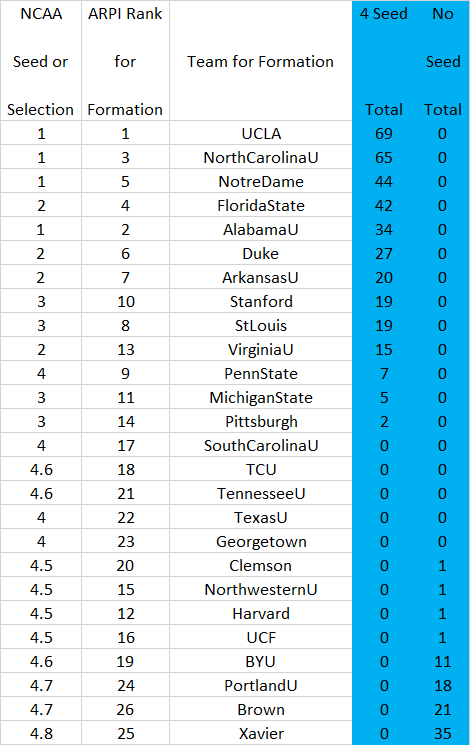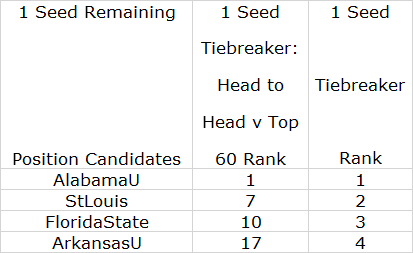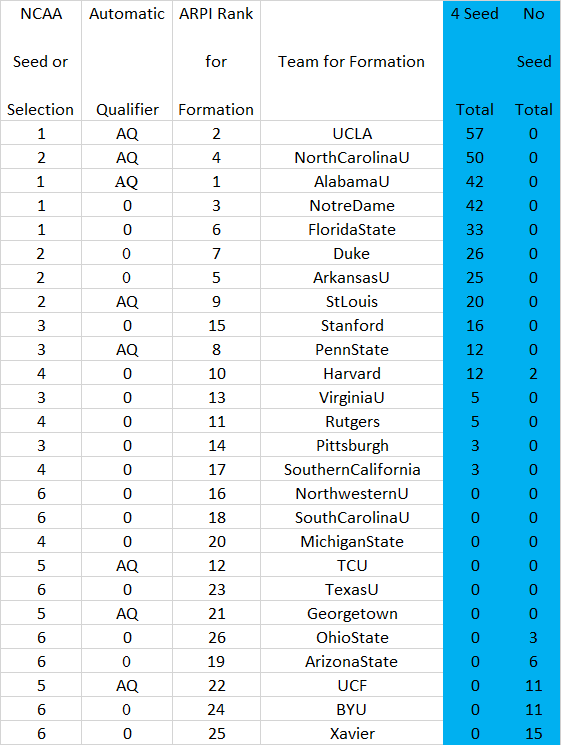Below are tables showing simulated seed and at large selection candidate groups based on the actual results of games played through October 9 and simulated results of games not yet played. There also is a table showing simulated conference champion automatic qualifiers. For the candidate groups for seeds and at large selections, each table shows how many historic patterns each team meets indicating that the team will or will not get a positive decision from the Committee. In addition, I have indicated potential Committee decisions based on the patterns.
I also have included some discussion to help readers understand how different considerations go into the decision process. The discussion is only to help with understanding, as the numbers in the tables will be different at the end of the season.
Reminder: From among the teams that are not automatic qualifiers, the Committee will pick 33 at large participants.
#1 Seeds
Historically, the #1 seeds have come from teams with ARPI ranks 1 through 7. The 1 Seed Total column shows the number of standards a team has met where a team meeting any one of the standards always has gotten a #1 seed. The No 1 Seed Total column is where meeting any one of the standards means the team never has gotten a #1 seed.
Since Virginia meets both yes and no standards, it has a profile the Committee has not seen before. I took a look at the no standards, to see what is negative about Virginia’s profile so far as a #1 seed is concerned.
One of the no standards combines RPI rank and conference standing, with each weighted at 50%. In the conference regular season standings, the simulation has Virginia finishing tied for 3rd and thus splitting the 3-4 positions. I treat this as finishing in position 3.5. In the conference tournament, the simulation has Virginia losing in the semi-finals. I treat both losing semi-finalists as splitting the 3-4 tournament positions, thus finishing in position 3.5. I then average the regular season standing and conference tournament finishing position which, in this case, comes out to 3.5 for Virginia. When I combine this with its #7 RPI rank, Virginia ends up with a score that is outside the range of teams that historically have gotten #1 seeds.
The other two no standards combine RPI rank with a poor results score and a poor results rank, respectively. In the simulation, the Virginia poor results score is -3, coming from its recent tie with Syracuse, which the simulation has ending the season ranked #126. Based on this, its poor results rank is #22. It is worth noting that statistically, for teams competing for as yet unfilled #1 seeds, poor results are one of the best correlators with Committee decisions.
In light of this, if the simulation results were the actual results in front of the Committee on decision day, UCLA, Alabama, and North Carolina would seem like clear #1 seeds, with Virginia, Notre Dame, and Duke as possibilities to fill the fourth position. The Committee then would have to decide how to treat Virginia, given its unique profile.
My suspicion is that, in this scenario, the Committee would give #1 seeds to UCLA, Alabama, North Carolina, and Notre Dame.
#2 Seeds
Historically, the #2 seed pool is teams ranked #14 or better. If the top 4 in this table have #1 seeds as I have suggested, then Virginia, Duke, and Arkansas are clear #2 seeds. This leaves St. Louis, Florida State, and Pittsburgh as possibilities to fill the last position. On looking at the St. Louis no standards, they all have to do with the Atlantic 10 conference -- either the conference average RPI or the conference RPI rank, which the simulation has as #10. Since 2007 (excluding Covid-affected 2020), no team from a conference ranked #9 or poorer has gotten a #1 seed. On the other hand, the St. Louis yes standards relate to its having had no poor results and its having had good results, on average, in its games against Top 60 opponents (6 games).
In this scenario, I suspect the Committee would give the last #2 seed to Florida State.
#3 Seeds
Historically, the #3 seed pool is teams ranked #23 or better. In this table, if the top 8 have #1 or #2 seeds, I see the Committee giving #3 seeds to Pittsburgh and St. Louis. This would leave 2 open positions for South Carolina, Penn State, Rutgers, and Northwestern as candidates. For #3 seeds, in filling open positions, the historically best tie-breaker has been a standard that combines team RPI rating and Top 60 Head to Head Score Rank. The two teams that score best on this are South Carolina and Rutgers. Thus I suspect the Committee would give them #3 seeds.
#4 Seeds
Historically, the #4 seed pool is teams ranked #26 or better. In this table, after taking out the #1 through #3 seeds, it looks like Penn State and Harvard are likely #4 seeds. The last two seeds should come from Northwestern, Portland, Texas, Xavier, and Georgetown. For #4 seeds, in filling open positions, the historically best tie-breaker has been a standard that combines team Top 50 Results Score and Top 60 Common Opponents Score. The two teams that score best on this are Nothwestern and Georgetown. Thus I suspect the Committee would give them #4 seeds.
Automatic Qualifiers
Here is a list of the automatic qualifiers the simulation currently produces:
At LargeHere is a table showing seeds, automatic qualifiers, at large selections, and Top 60 teams not getting at large selections. In the table:
1 = #1 seed
2 = #2 seed
3 = #3 seed
4 = #4 seed
5 = unseeded automatic qualifier
6 = unseeded at large selection
7 = Top 60 team not getting an at large selection
The at large selections are pretty clear, with one exception: Virginia Tech. Its most obvious problem is that it has a #59 RPI rank, and since 2007 no team ranked #58 or poorer has gotten an at large selection. On the other hand, its most obvious plus is that it has the #11 ranked Top 50 Results Score (using my scoring system). In the simulation, this comes mostly from a win over North Carolina, which I have as a #1 seed. So the Committee question is this: Are we going to exclude a team because it is ranked #59, when it has shown it is able to compete at the level of our #1 seeds? I suspect the Committee would give Virginia Tech an at large position, as assigned in the above table.



















































